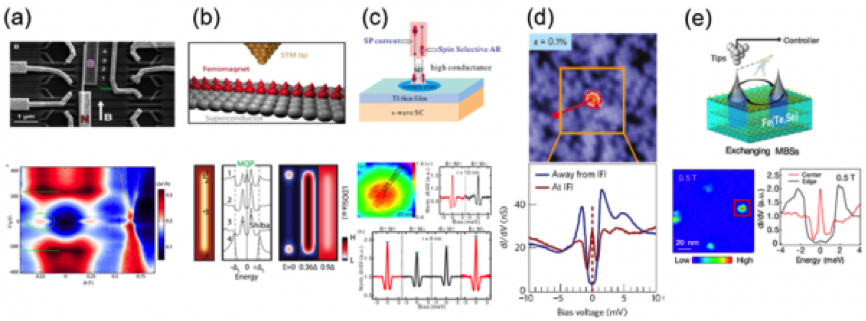Majorana bound state research moves ahead in leaps and bounds
2019-04-26
The Majorana zero mode in the semiconductor-superconductor nanowire is one of the promising candidates for topological quantum computing. Recently, in islands of nanowires, subgap-state energies have been experimentally observed to oscillate as a function of the magnetic field, showing a signature of overlapped Majorana bound states. However, the oscillation amplitude either dies away after an overshoot or decays, sharply opposite to the theoretically predicted enhanced oscillations for Majorana bound states.
Earlier this month, Physical Review Letters (PRL) published the latest theoretical developments on the Majorana oscillation in semiconductor-superconductor nanowires that resulted from collaboration between the Department of Physics at Southern University of Science and Technology (SUSTech) and the Shenzhen Institute of Quantum Science and Engineering (SIQSE). The paper, entitled “Decays of Majorana or Andreev Oscillations Induced by Steplike Spin-Orbit Coupling,” sought to reveal a steplike distribution of spin-orbit coupling in realistic devices that induces the decaying Majorana oscillations, resulting from the coupling-induced energy repulsion between the quasi-particle spectra on the two sides of the step.

The Majorana fermion is an electrically neutral fermion. In 1937, the Italian theoretical physicist Ettore Majorana published a paper imagining the existence of such particles, hence the name. Because it follows non-Abelian statistics, the Majorana bound state in topological superconductors can be used for topological quantum computing. Research into topological quantum computing is currently funded by many IT companies such as Microsoft.
Recent experimental and theoretical predictions about Majorana oscillations in nanowires are currently inconsistent, which has led to researchers questioning the existence of the Majorana bound state. This theoretical development explains the recent Majorana oscillation experiment by proposing a non-uniform spin-orbit coupling.
The search for the Majorana fermion has been carried out intermittently for more than half a century. Candidates have included neutrinos, supersymmetric spin ½ Fermion partners of photons in supersymmetry theory, and weak interactions in celestial dark matter with mass particles. This article only talks about recent advances in condensed matter physics.
This study is important for two reasons. Firstly, it considers the possibility that the Majorana fermion may be a basic particle, and secondly it considers that the quasi-particle Majorana bound state associated with the Majorana fermion can be found in the condensed matter system. This lends itself towards topological quantum computing, a form of quantum computing that is far more stable, hence the interest by major IT companies for commercial applications.
The critical breakthrough has come from using a semiconductor-superconductor nanowire-based solution. Other research groups around the world have researched similar proposals. These research projects tended to find that the theory behind splitting energy oscillation of the Majorana bound state would not hold up under experimental conditions. Instead, the amplitude of Majorana oscillation would decay as the magnetic field increases, instead of increasing with the magnetic field.

The SUSTech-SIQSE team discovered that previous research had ignored a critical factor, in that the spin-orbit coupling in the experimental nanowires is not consistent, or indeed nonuniform. The electric field and screening effect both modulate the spin-orbit coupling size within the nanowire structure. Simple models would assume the nanowires are divided into two segments of two different spin-orbit coupling sizes, which immediately sets the assumption for the Majorana oscillation and other matters throughout the calculations. However, if the assumption about the attenuation of the Majorana oscillation is incorrect, then further problems will follow. More complex models, as created by the SUSTech-SIQSE team, show that the attenuation of various orbits can be fitted into the model, creating more certainty for the existence of uneven spin-orbit coupling in the nanowires.
In the last 10 years, there has been continuous and consistent study on the Majorana bound states and their related topological quantum computations. These studies will continue into the future, as there is a need to understand the use of non-Abelian statistics and braiding operations of the Majorana bound state to achieve stable topological quantum computing.
The first author is postdoctoral researcher Cao Zhan. The communication author is Professor Lu Haizhou. Collaborators include Professor Zhang Hao from Tsinghua University, Professor Lü Haifeng from the University of Electronic Science and Technology, Doctor He Wanxiu from Lanzhou University, and Academician Xie Xincheng from Peking University.
This work was supported by the Strategic Priority Research Program of Chinese Academy of Sciences, the Guangdong Innovative and Entrepreneurial Research Team Program, the National Basic Research Program of China, the National Key R & D Program, the National Natural Science Foundation of China, and the Shenzhen Municipal Science, Technology and Innovation Commission.
Article link: https://journals.aps.org/prl/abstract/10.1103/PhysRevLett.122.147701




